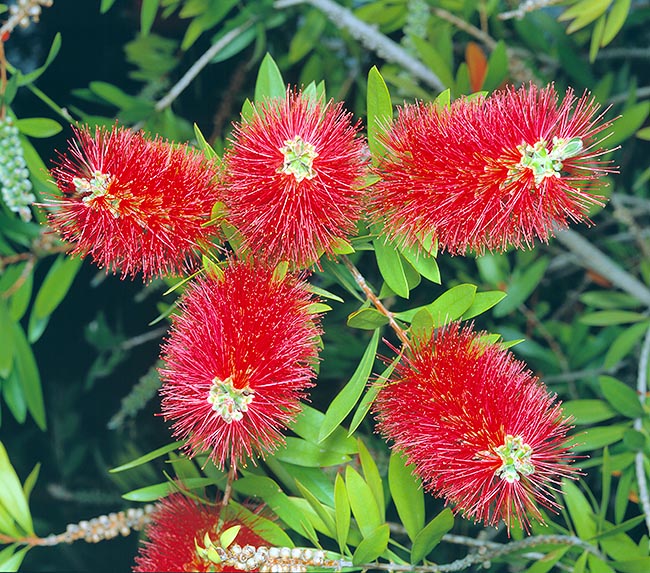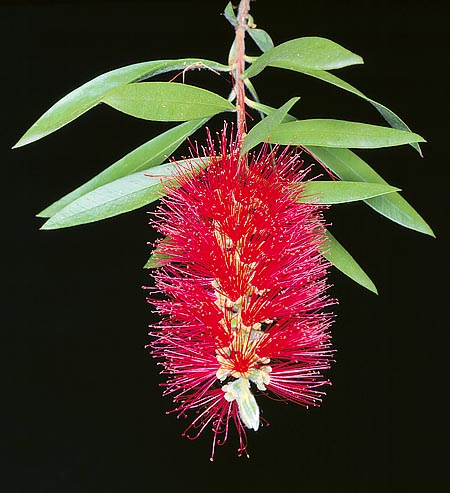Family : Myrtaceae

Text © Pietro Puccio

English translation by Mario Beltramini

Callistemon speciosus is an Australian shrub with showy bottlebrushes-like inflorescences © Giuseppe Mazza
The name of the genus is the combination of the Greek terms “kallos” = beauty and “stémon” = stamen; the name of the species is the Latin term “speciosus” = beautiful.
Common names: Albany bottlebrush, swamp bottlebrush (English); rince-bouteilles (French); panacheiro (Portuguese); escobillón rojo, gusanillo, limpiatubos (Spanish); Zylinderputzer (German).
The Callistemon speciosus (Sims) Sweet (1826) is an evergreen shrub or small tree with grey or brownish bark, fissured, tall up to about 8 metres with globose crown and almost drooping branches. The leaves, on a short petiole, have an intense green colour, are alternate, simple, lanceolate with sharp apex or obtuse, rigid, 4-10 cm long and 0,5-1 cm broad, aromatic due to the presence of oleiferous glands.
The inflorescences are thick terminal spikes, cylindrical, 5 to 15 cm long, with several flowers with 5 sepals and 5 green petals, about 0,6 cm long, and several free stamina, 2,5 cm long, of bright red colour with yellow anthers, which are the most conspicuous part of the flower. The fruits are woody, globose, capsules, of 5-7 mm of diameter, depressed at the apex, persistent for long, containing numerous tiny seeds.
It reproduces by seed placed superficially in sandy soil, kept constantly humid, in luminous position and at the temperature of 20-22 °C; the germination takes place between 4 and 8 weeks with rather slow initial growth; it reproduces also by cutting in summer and by air layering.

Cylindrical terminal spikes with countless red stamina © Giuseppe Mazza
It is a much floriferous species and of easy cultivation which characterizes for its adaptability to different climatic conditions, as it bears long periods of dry in summer, once well rooted, but also constant humidity, and types of soil, even if preferring the acidic or neutral ones.
The best exposition is in full sun, but it can stand light shading; for what temperatures are concerned, it bears the high as well as the low ones, at least up to about -6 °C.
It may be utilized as isolated specimen as well as for fences and for its contained size and the long flowering, going on from early spring to summer, it is an excellent subject as road tree.
It can be cultivated also in pot for the decoration of terraces and patios, in soil rich of organic substance, acidic and with addition of sand around the 30%; eventual prunings are to be done after the flowering.
The essential oil extracted from the leaves, which has as main component the cineol (eucalyptol), is known for its antiseptic, expectorant and bronchodilatory properties.
Synonyms: Metrosideros crassifolia Dum.Cours. (1811); Metrosideros glauca Dum.Cours. (1811); Melaleuca paludosa R.Br. (1812); Metrosideros speciosa Sims (1815); Callistemon speciosus (Sims) DC. (1828); Callistemon glaucus (DC.) Sweet (1830); Callistemon heleogiton Domin (1928).
→ To appreciate the biodiversity within MYRTACEAE family please click here.
